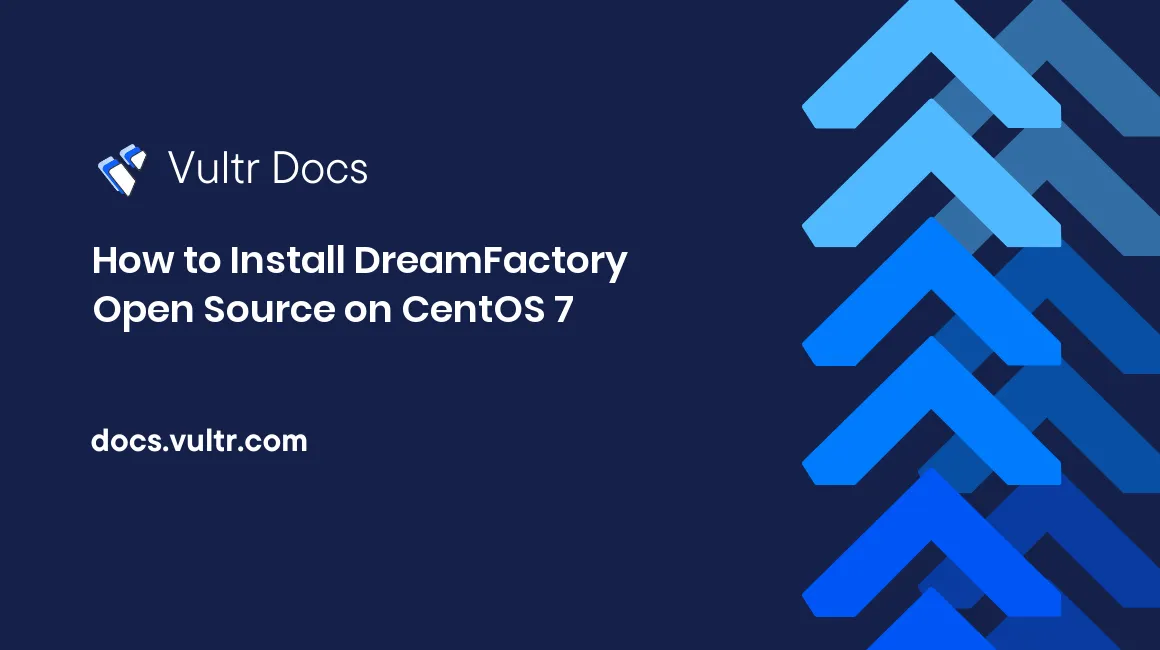
DreamFactory is an open source program which can turn any database into a RESTful API platform.
DreamFactory can be deployed on various platforms. In this article, we will be installing DreamFactory Open Source Edition on a CentOS 7 server.
Prerequisites
- A CentOS 7 x64 server instance.
- A sudo user.
Step 1: Update the system
Log into your system as a sudo user from an SSH terminal, and then update the system as follows:
sudo yum install epel-release -y
sudo yum update -y
sudo shutdown -r nowStep 2: Install Apache
As required by DreamFactory, you need to install the Apache web server using YUM:
sudo yum install httpd -yRemove the default Apache welcome page:
sudo sed -i 's/^/#&/g' /etc/httpd/conf.d/welcome.confDisable Apache’s public directory and file listing:
sudo sed -i "s/Options Indexes FollowSymLinks/Options FollowSymLinks/" /etc/httpd/conf/httpd.confStart the Apache service and enable it on system boot:
sudo systemctl start httpd.service
sudo systemctl enable httpd.serviceStep 3: Install MariaDB
For this tutorial, we will be using MariaDB 10.1 as the database server DreamFactory will be using.
3.1 Setup the MariaDB 10.1 YUM repo
Use the following code segment to create the MariaDB 10.1 YUM repo:
cat <<EOF | sudo tee -a /etc/yum.repos.d/MariaDB.repo
# MariaDB 10.1 CentOS repository list - created 2017-01-14 03:11 UTC
# http://downloads.mariadb.org/mariadb/repositories/
[mariadb]
name = MariaDB
baseurl = http://yum.mariadb.org/10.1/centos7-amd64
gpgkey=https://yum.mariadb.org/RPM-GPG-KEY-MariaDB
gpgcheck=1
EOF3.2 Install MariaDB 10.1 using YUM
sudo yum install MariaDB-server MariaDB-client -y3.3 Start and enable the MariaDB service
sudo systemctl start mariadb.service
sudo systemctl enable mariadb.service3.4 Secure the installation of MariaDB
sudo /usr/bin/mysql_secure_installationAnswer questions as follows, and be sure to enter your own MariaDB root password.
- Enter current password for root (enter for none): Just press the
Enterbutton - Set root password? [Y/n]:
Y - New password:
<your-password> - Re-enter new password:
<your-password> - Remove anonymous users? [Y/n]:
Y - Disallow root login remotely? [Y/n]:
Y - Remove test database and access to it? [Y/n]:
Y - Reload privilege tables now? [Y/n]:
Y
3.5 Create a MariaDB database for DreamFactory
Log into the MySQL shell as root:
mysql -u root -pEnter the MariaDB root password you set in step 3.4 in order to log in.
In the MySQL shell, create a database dreamfactory, a database user dreamfactoryuser, and its password yourpassword as follows.
Note: For security purposes, you MUST replace the three sample parameters mentioned above with your own ones.
CREATE DATABASE dreamfactory;
CREATE USER 'dreamfactoryuser'@'localhost' IDENTIFIED BY 'yourpassword';
GRANT ALL PRIVILEGES ON dreamfactory.* TO 'dreamfactoryuser'@'localhost' IDENTIFIED BY 'yourpassword' WITH GRANT OPTION;
FLUSH PRIVILEGES;
EXIT;Step 4: Install PHP 7.x and Composer
4.1 Install PHP 7.1 and necessary extensions
On CentOS 7, you can install PHP 7.1 and necessary PHP extensions using the Webtatic YUM repo:
sudo rpm -Uvh https://mirror.webtatic.com/yum/el7/webtatic-release.rpm
sudo yum install mod_php71w php71w-common php71w-cli php71w-gd php71w-mbstring php71w-mcrypt php71w-xml php71w-mysqlnd php71w-pecl-mongodb -y4.2 Install Composer
Install the latest release of Composer, which is 1.3.1 at the time of writing, as below.
Note: The instructions above may change in should Composer update their installation instructions. As such, you should always check out the official Composer download page in order to get the most up-to-date installation instructions.
cd
php -r "copy('https://getcomposer.org/installer', 'composer-setup.php');"
php -r "if (hash_file('SHA384', 'composer-setup.php') === '55d6ead61b29c7bdee5cccfb50076874187bd9f21f65d8991d46ec5cc90518f447387fb9f76ebae1fbbacf329e583e30') { echo 'Installer verified'; } else { echo 'Installer corrupt'; unlink('composer-setup.php'); } echo PHP_EOL;"
php composer-setup.php
php -r "unlink('composer-setup.php');"4.3 Make Composer globally available
sudo mv composer.phar /usr/local/bin/composerStep 5: Install Git and DreamFactory
5.1 Install Git
sudo yum install git -y5.2 Install DreamFactory
Download the latest stable release of DreamFactory, which is 2.4.2 at the time this article was written, then install DreamFactory and dependencies as follows:
cd
wget https://github.com/dreamfactorysoftware/dreamfactory/archive/2.4.2.tar.gz
tar -zxvf 2.4.2.tar.gz
cd dreamfactory-2.4.2
composer install --no-dev
sudo mv ~/dreamfactory-2.4.2 /opt
sudo chown -R root:root /opt/dreamfactory-2.4.2
sudo chown -R apache:apache /opt/dreamfactory-2.4.2/storage/ /opt/dreamfactory-2.4.2/bootstrap/cache/
sudo chmod -R 2775 /opt/dreamfactory-2.4.2/storage/ /opt/dreamfactory-2.4.2/bootstrap/cache/
cd /opt/dreamfactory-2.4.2Use the following command to create a .env file to store DreamFactory configurations:
sudo php artisan dreamfactory:setupWhen prompted, input database settings as follows:
Which database would you like to use for system tables? [sqlite]:
[0] sqlite
[1] mysql
[2] pgsql
[3] sqlsrv
> 1
Enter your mysql Host:
> localhost
Enter your database name:
> dreamfactory
Enter your database username:
> dreamfactoryuser
Enter your database password:
> yourpassword
Re-enter your database password:
> yourpassword
Enter your Database Port [3306]:
> 3306Run the same command again in order to setup the first admin user:
sudo php artisan dreamfactory:setupWhen prompted, input credentials as follows:
Creating the first admin user...
Enter your first name:
> John
Enter your last name:
> Doe
Enter display name:
> John Doe
Enter your email address?:
> admin@example.com
Choose a password:
> <your-admin-password>
Re-enter password:
> <your-admin-password>5.3 Prepare for web access
Set up a virtual host for DreamFactory. Use the following code segment to setup a virtual host. Remember to replace the values of ServerAdmin, ServerName, ServerAlias, Errorlog, and CustomLog with your own ones.
cat <<EOF | sudo tee -a /etc/httpd/conf.d/dreamfactory.conf
<VirtualHost *:80>
ServerAdmin admin@example.com
DocumentRoot /opt/dreamfactory-2.4.2/public/
ServerName dreamfactory.example.com
ServerAlias www.dreamfactory.example.com
<Directory /opt/dreamfactory-2.4.2/public/>
Options FollowSymLinks
AllowOverride All
AllowOverride None
Require all granted
RewriteEngine on
RewriteBase /
RewriteCond %{REQUEST_FILENAME} !-f
RewriteCond %{REQUEST_FILENAME} !-d
RewriteRule ^.*$ /index.php [L]
<LimitExcept GET HEAD PUT DELETE PATCH POST>
Allow from all
</LimitExcept>
</Directory>
ErrorLog /var/log/httpd/dreamfactory.example.com-error_log
CustomLog /var/log/httpd/dreamfactory.example.com-access_log common
</VirtualHost>
EOFPut your modifications into effect by restarting the Apache service:
sudo systemctl restart httpd.serviceModify firewall rules in order to allow web access:
sudo firewall-cmd --zone=public --permanent --add-service=http
sudo firewall-cmd --reloadStep 6: Access DreamFactory
Point your web browser to http://203.0.113.1 to access DreamFactory, and then use the admin email address and password you set earlier to log in.
This concludes our tutorial. Thanks for reading.
No comments yet.